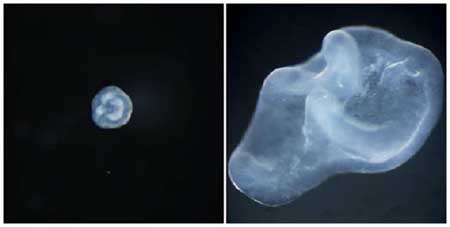| RIKEN Center for
Developmental Biology (CDB) 2-2-3 Minatojima minamimachi, Chuo-ku, Kobe 650-0047, Japan |
| 2b or not 2b a stem cell | ||
May 20, 2005 – During the development of the vertebrate retina, a whole spectrum of cells, including both neural and glial cells, arise from a cadre of precursor cells, known as retinal progenitors. These progenitors are present throughout the developing neural retina, but show differential proliferation, with the cells at the outer fringes remaining in an undifferentiated, proliferative state for much longer than those in the central region. These dual capacities for proliferation and differentiation mark the marginal retinal progenitors as one form of stem cell, and as with all such cells, the means by which external factors exert control over the balance between this pair of functions remains an intriguing and important question.
The Wnt family of proteins includes many secreted factors that function in a staggering range of developmental processes. In the formation of the retina, it was previously reported that Wnt2b is expressed in the anterior rim of the optical vesicle (the most marginal part of the nascent retina), which neighbors the stem cell-containing peripheral retina. Nakagawa focused on the possible involvement of this signaling factor in ensuring that the progenitor cells refrain from committing to more highly differentiated cellular fates, which is critical to their function as stem cells. Specifically, his team was curious to discover whether Wnt activity was restricted solely to the periphery of the neural retina, and whether Wnt2b was indeed directly responsible for the inhibition of differentiation. While they showed both of these to be the case in previous work (Kubo et al., 2003, Nakagawa et al., 2003), they made the additional interesting finding that Wnt2b’s function as a repressor appears not to be linked to the function of a second signaling program, the Notch pathway, which is known to suppress neural and promote glial differentiation in the retina. Nakagawa first looked at the effects of overexpressing either Wnt2b or Delta (the ligand that binds the Notch receptor) on cell proliferation in the developing retina and found that while Delta-expressing tissue had ceased growing after about two days, the Wnt culture continued to proliferate for eight or more, showing Wnt2b to be the likelier promoter of proliferation. Next, the lab prepared Wnt2b and Delta tissue explants in which genes specific to neurons, glia and undifferentiated cells could be visualized by immunohistochemistry, and found that in both the Wnt2b and Delta explants the expression of neuronal markers was inhibited and that of undifferentiated cells was upregulated. But only the Wnt cells continued to proliferate, while cells in the Delta explant uniformly expressed glial markers. In essence, although both the Wnt and Notch pathways seemed to be capable of inhibiting differentiation into neurons, only Wnt seems able to keep the undifferentiated cells proliferating as well. The fact that Wnt2b was able to rescue cells from the premature neuronal differentiation caused by interference with the Delta/Notch cascade lent further credence to the idea that Wnt works by an independent mechanism in this population of cells. The question then is, how does Wnt inhibit differentiation in retinal progenitor cells if not via Notch? The Nakagawa team sought to address this question by looking at the relationship between the expression of Wnt2b and that of a number of proneural genes, which are essential for the differentiation of retinal neurons. They found that, in the Wnt2b explants, the activity of all proneural genes was significantly downregulated or absent, as indeed was the expression of Notch. These results suggest that Wnt signaling may be shutting down both proneural and Notch activity in retinal progenitors, enabling these cells to avoid differentiation into either neural or glial cells and to remain both uncommitted and proliferative.
|
||
|
||
[ Contact ] Douglas Sipp : sipp@cdb.riken.jp TEL : +81-78-306-3043 RIKEN CDB, Office for Science Communications and International Affairs |
| Copyright (C) CENTER FOR DEVELOPMENTAL BIOLOGY All rights reserved. |
